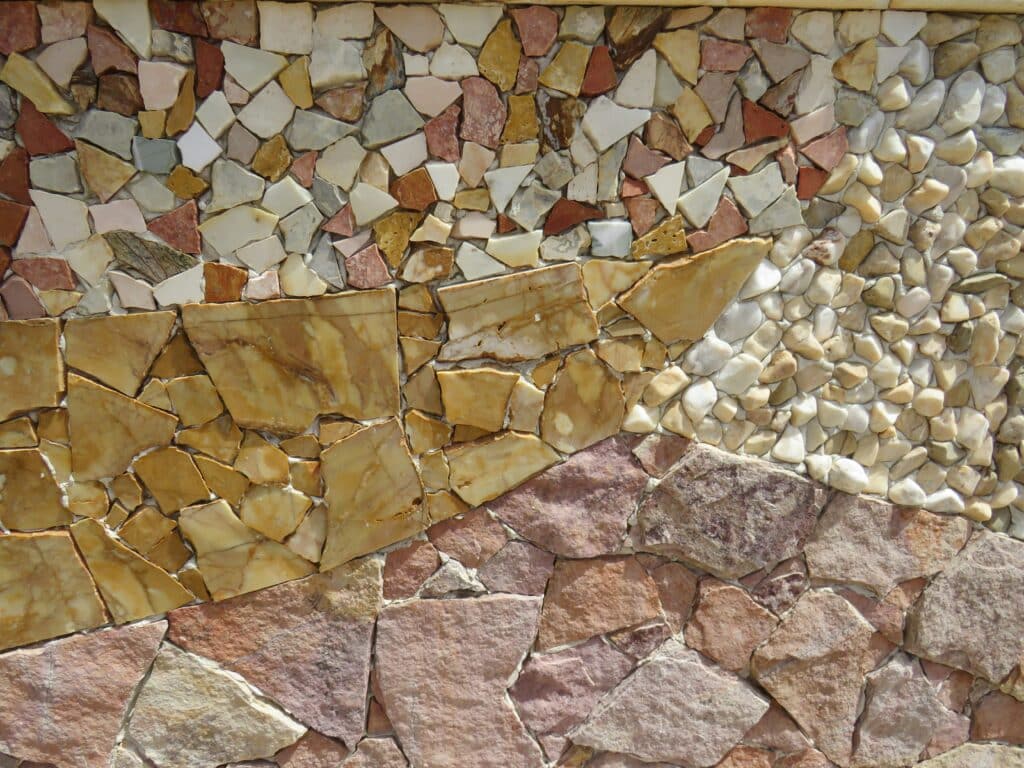This introduction aims to guide you in exploring the potential of natural stone decor in transforming your outdoor space. Prepare to be captivated as you discover how these beautiful and durable tiles can completely revolutionize your garden and turn it into a breathtakingly beautiful sanctuary.
The natural beauty of stone mosaic path tiles is undeniable. These timeless pieces hold the power to transform ordinary gardens into extraordinary spaces. They offer an impeccable blend of durability and aesthetics, effortlessly adding a touch of elegance to any outdoor area. The versatility of these tiles also enables you to use them in a variety of ways to enhance your garden’s overall appeal.

Stay tuned as we delve deeper into the world of stone mosaic path tiles. We’ll be uncovering their unique properties, how they can be incorporated into different garden designs, and why they make an excellent choice for your outdoor decor. Be ready to be inspired and gain insightful tips on how to elevate your garden space with natural stone decor. Immerse yourself in the world of exquisite garden transformations as we unfold the magic of stone mosaic path tiles.
A Timeless Fusion of Craftsmanship, Nature, and Landscape Elegance
In the world of garden design, few features are as enchanting and enduring as stone mosaic path tiles. These intricate, handcrafted walkways fuse functionality with artistic expression, bringing a sense of permanence and poetry to any outdoor space. From the winding footpaths of European villas to tranquil Zen gardens in Asia, stone mosaics have long served as both practical surfaces and storytelling canvases across cultures and centuries.
What makes stone mosaic paths particularly compelling is their ability to weave art into everyday living. Unlike generic pavers or synthetic slabs, each stone tile in a mosaic has a purpose—whether it be to form a pattern, define movement, or create visual rhythm. Walkways become more than just routes from point A to B; they become meditative journeys, inviting guests to slow down, appreciate craftsmanship, and connect with the surrounding natural environment.
Stone mosaic path tiles are not merely decorative. They represent a deep connection between human creativity and the earth’s raw elements. Each piece—cut, shaped, or selected for its uniqueness—retains traces of the geological time it has weathered. Laying them together is both a design decision and an act of reverence for nature’s diversity and texture.
These paths, whether subtle or elaborate, are symbols of careful planning, patience, and permanence. They honor the past, yet remain remarkably timeless, suitable for both contemporary minimalist spaces and lush, eclectic gardens. In addition, mosaic paths can echo cultural identity, commemorate loved ones, or simply reflect the artistic whim of the homeowner.
In this guide, we will explore every aspect of these artistic paths, including their history, benefits, construction process, creative inspirations, maintenance, and ecological value. Whether you are envisioning a whimsical backyard walkway or a grand estate entrance, this article will help you understand how stone mosaic path tiles can transform your landscape into a living, walkable work of art.
What Are Stone Mosaic Path Tiles?
Stone mosaic path tiles are surfaces formed by arranging small, often irregularly shaped pieces of natural stone—such as marble, slate, granite, limestone, or travertine—into decorative patterns. These pieces, known as tesserae, are carefully placed to create geometric designs, images, or abstract compositions.
Mosaic tiling in pathways is a form of hardscaping—the use of durable materials in landscaping. But unlike concrete slabs or simple pavers, mosaic paths allow homeowners and landscape designers to infuse individuality, style, and symbolism into their gardens.
Each piece of stone has its own texture, color, and story—together, they create a harmonious tapestry underfoot.
Historical and Cultural Significance
The use of mosaics dates back thousands of years. From ancient Mesopotamia to Roman villas, mosaics adorned floors, walls, and walkways, often telling stories of gods, mythology, or daily life. Roman stone mosaics, especially those made with black and white pebbles or colorful marble, are some of the most enduring examples of the craft.
In Islamic architecture, mosaic tiling evolved into elaborate geometric patterns, representing the infinite nature of creation. In Asian gardens, stone paths were not only functional but also deeply symbolic, guiding visitors on mindful, meditative journeys.
By incorporating mosaic tiles into modern paths, we’re honoring this rich artistic lineage while adding lasting beauty and functionality to our outdoor spaces.
Characteristics of Stone Mosaic Path Tiles
Stone mosaic path tiles are known for their visual texture, color variety, and versatility. Their main characteristics include:
1. Material Diversity
- Granite: Dense and highly durable; excellent for contemporary aesthetics
- Slate: Rich color layers; great for rustic or earthy tones
- Limestone and Travertine: Softer in appearance; ideal for classic or Mediterranean themes
- Marble: Polished, luxurious feel; often used for focal points
2. Pattern Flexibility
You can craft nearly any design—from simple cobblestone spirals to intricate botanical motifs or even pictorial scenes.
3. Color Harmony
Natural stone comes in a wide range of hues: muted greys, earthy reds, oceanic blues, and golden ambers. This allows your mosaic path to coordinate with your landscape’s natural palette.
4. Longevity
Stone mosaics, when installed properly, can last decades or even centuries. They age beautifully, gaining patina and character over time.
Benefits of Stone Mosaic Path Tiles
While aesthetics are a major draw, the functional and environmental benefits of stone mosaic paths are equally compelling.
1. Durability and Weather Resistance
Natural stone is remarkably resilient. It withstands UV rays, rain, frost, and foot traffic without cracking or fading. This makes mosaic paths an ideal choice for regions with changing climates.
2. Slip Resistance
The uneven texture of natural stone tiles offers superior traction, even when wet—reducing the risk of slips, especially in areas like poolsides or shaded garden corners.
3. Low Maintenance
A stone mosaic path is surprisingly easy to maintain. Occasional sweeping and rinsing keep it clean, and periodic sealing (depending on stone type) maintains its integrity.
4. Increased Property Value
A well-designed stone mosaic walkway adds curb appeal and perceived luxury to your home, potentially increasing resale value.
5. Eco-Friendliness
Natural stone is a sustainable material, especially if sourced locally or reclaimed. Mosaic paths allow for the use of offcuts and small pieces that would otherwise be discarded, reducing construction waste.
Designing a Stone Mosaic Path: Step-by-Step
Designing and building a stone mosaic path may sound daunting, but with planning, patience, and creativity, it becomes a rewarding project. Here’s how to approach it.
Step 1: Inspiration and Concept Development
Start by browsing images of mosaic paths. Do you prefer symmetry or spontaneity? Are you drawn to ancient patterns, floral themes, or abstract swirls?
Sketch your ideas on paper or use digital design tools. Determine the path’s:
- Length and width
- Purpose (purely decorative, or a walking path?)
- Surrounding elements (plants, furniture, water features)
Step 2: Selecting Stones
Consider the following when choosing your stones:
- Size and shape: Uniform pebbles vs. irregular fragments
- Color palette: Monochrome for elegance or multicolor for vibrancy
- Texture: Smooth stones create flow; rough stones add traction
Sources include:
- Landscape supply stores
- Local quarries
- Salvage yards (for reclaimed stone)
- Online artisan suppliers
Step 3: Preparing the Path Area
Mark the area with string, stakes, or chalk. Dig down about 4 to 6 inches, depending on your climate and stone thickness.
Layer the base as follows:
- Gravel (2–3 inches) – for drainage and foundation
- Sand (1–2 inches) – for leveling and bedding
Compact each layer thoroughly.
Laying the Mosaic
Dry Layout
Before setting anything in stone, lay out your design without adhesive. This lets you tweak placement and ensure balance.
Mortar or Dry-Lay?
- Mortar (cement mix): Best for permanent, high-traffic paths
- Dry-lay (sand only): Easier, more forgiving, but may shift over time
Apply mortar (if using) in small sections. Press each stone firmly into place, using a rubber mallet if needed.
Grouting
Once the stones are set and the mortar has cured, fill gaps with grout or polymeric sand. This stabilizes the surface and enhances the pattern.
Sealing
Use a stone sealant to protect from stains, moisture, and moss growth—especially in shaded or damp environments.
Creative Design Ideas
The joy of mosaic paths lies in their versatility. Consider these themes:
1. Celtic Knots or Mandalas
Intricate loops and spirals add mysticism and cultural heritage to garden spaces.
2. Floral Motifs
Use colored stones to mimic petals, stems, and leaves—perfect for cottage gardens.
3. Animal Silhouettes
Create a turtle, dragonfly, or bird using contrast stones for playful focal points.
4. Wave or River Flows
Arrange stones in sinuous patterns to mimic flowing water—ideal for Zen-style gardens.
5. Word or Quote Inlays
Incorporate short words, names, or inspiring phrases with engraved or colored stone.
Maintenance Tips for Long-Term Beauty
While stone mosaic paths are low-maintenance, a few routines help keep them pristine.
- Monthly: Sweep away leaves and debris
- Seasonally: Rinse with water; use stone-safe detergent if needed
- Annually: Inspect for loose stones or cracks; reseal if necessary
- Weed control: Use natural solutions (vinegar, boiling water) to keep gaps clear
Environmental Impact and Sustainability
Stone mosaic paths reflect sustainable values:
- Long lifespan reduces replacement and landfill waste
- Natural materials are non-toxic and biodegradable
- Use of scraps reduces demand for new extraction
- Water permeability (if dry-laid) helps prevent runoff and erosion
For added sustainability, choose locally sourced or salvaged stones, and avoid adhesives with harmful chemicals.
Incorporating Mosaic Paths into Overall Landscape Design
Mosaic walkways work beautifully with various garden elements:
- Pair with raised beds or borders of ornamental grasses
- Frame with solar lights or lanterns for magical nighttime ambiance
- Lead to a focal point like a fountain, sculpture, or pergola
- Alternate with stepping stones or grass inlays for a more organic look
The key is harmony—let the path guide the eye and invite exploration.
Final Reflections: Art Beneath Your Feet
Stone mosaic path tiles are more than just walkways. They are stories told in stone, threads of culture and creativity woven into the very earth. They speak of patience, artistry, and an enduring relationship between people and place.
Whether you craft your own by hand or commission a professional artisan, the result is a one-of-a-kind feature that anchors your garden and elevates your outdoor experience.
In a world of synthetic solutions, mosaic paths ground us—literally and spiritually. They teach us to tread gently, to admire detail, and to find joy in simple things, like a stone fitting perfectly into a bigger picture.
So go ahead—lay the first stone on your journey toward a more beautiful, expressive, and sustainable landscape. 🪨🌿✨
Conclusion
Transforming your garden with stone mosaic path tiles not only elevates your outdoor space but also adds a touch of natural elegance to your landscape. These mosaic tiles, designed from natural stones, are a perfect way to breathe new life into your garden, and simultaneously enhancing the overall aesthetic appeal of your home. Their incredible durability and low maintenance needs further add to their appeal, offering you a stylish yet practical solution for your garden.
Furthermore, by opting for these stone path tiles, you are inviting nature into your living space, thus establishing a serene and calming ambiance. The versatility of these tiles also allows you to express your creativity and style in a myriad of ways, from intricate designs to simple, minimalist looks.
Therefore, whether you’re a seasoned gardener or a homeowner looking to spruce up your outdoor area, investing in stone mosaic path tiles can provide a remarkable transformation. So, why wait? Start your journey to create an exceptional outdoor space with these natural stone decor items, and witness your garden come alive with a distinct charm and allure.
Remember, your garden is an extension of your personality, and with stone mosaic path tiles, you can make it a true reflection of your unique style and taste. Let these natural stone pieces of art help you create a garden that is not just visually appealing but also a haven of tranquility and beauty.



